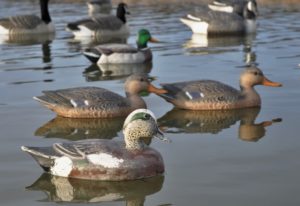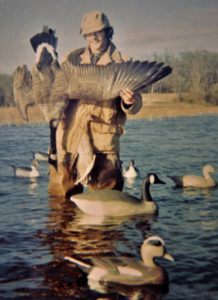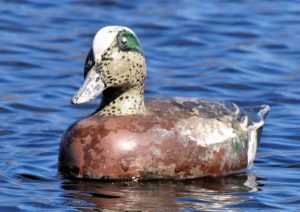Photography courtesy of Lowell Washburn, all rights reserved.
Waterfowl hunters – perhaps even more so than anglers – are hopelessly susceptible to product advertising. New guns, improved ammo, quieter motors, lighter boats, warmer coats, better waders, you name it – all beg to be purchased and tested.
Decoys are my personal weakness — the Achille’s heel of my outdoor pocket book. I’ve been fascinated with decoys for about as long as I can remember. If a new decoy hits the market, I’m compelled to try it.
Right now, I’m in search of the perfect decoy — a long running crusade that began sometime in the 1960s. If I were to name all the brands and models that I’ve sampled during the past half century, the list would exceed the space I’m allowed for this column. A few of those decoy companies are still in business. Most are not. And although it’s taken me a long while to get there, I’ve finally reached my conclusion on which decoy is perfect. Ready? The harsh reality is that there is no such thing as a perfect decoy. Nowhere; no how. The mythical model of perfection simply does not exist.
From the cheapest to the most expensive, all decoys exhibit both good and bad traits. Some have beautiful, lifelike designs but won’t hold paint. Other decoys can’t stand up to everyday use. Developing hairline fractures, inferior dekes soon become sinking ships. Decoys made of high-density foam look great out of the box but may easily dent or, when coming into contact with a few drops of boat gas, will self-destruct faster than the assignment tape at Mission Impossible.
So, given the fact that absolute perfection is clearly out of the question, and that each brand has its own unique combination of both good and bad characteristics; is it still possible to point to a single factory produced, synthetic decoy that surpasses all others? A model that is realistic, durable, well painted, and able to withstand the test of time better than all the rest? It’s all a matter of opinion, of course, but I think I have found the winner. That uniquely superior product is the Trend decoy.
If you’ve never heard of the Trend Decoy Company, don’t feel bad. Not many folks have. I first became aware of the Whitehouse, Florida based company while thumbing through a 1966 issue of Outdoor Life. As an already certified decoy nut, I immediately sent for the company’s free brochure.
When the full color pamphlet arrived, the decoys looked fantastic. Unfortunately, I had already blown my teenage summer bank roll on the purchase of three dozen Herter’s mallard decoys, a case of Remington high brass shot shells, a new pair of hip boots, and a used 1953 Dodge for eighty bucks. The good news was that I was not completely broke. I still had enough leftover cash to order a Trend sample. The company offered many species, and making a choice was no easy matter. After hours of agonizing consideration, I finally decided on a drake wigeon – a decoy I did not already own.
Upon arrival, the Trend wigeon was everything I’d hoped for. The decoy was simple but realistic; its hard shell filled with unsinkable foam. When tested in rough waters, it rode the waves like a real duck. I suddenly wished for more money.
Because of its novelty, the wigeon quickly became my pet decoy. Day after day, year after year, warm weather or cold, no matter where I hunted, the wigeon was there. Big water, backwater, marsh, or river, the handsome drake was always in the spread.
As the seasons rolled by, I eventually began to wonder just how many ducks the old decoy had seen circle overhead. Iowa duck hunting during the late 1960s was beyond fantastic. The late ‘70s were better yet. During many of those seasons, the bag limit was ten ducks per day for most species and the big migrations still came down through Iowa. In spite of holding down jobs and raising families, many of the guys I hunted with managed to bag 80 to 100 or more ducks per season.
Although some of our decoys lasted many years, most factory produced plastics only survived a few seasons before yielding to the elements. The Trend wigeon became a notable exception. Through thick and thin, the wigeon has withstood the test of time – surviving more than half a century of continual hard use. Although the decoy has worn through several coats of paint and is clearly showing its age, the drake remains as serviceable as the day it was molded. We’ve shared countless waterfowling adventures, and I can never hold that old decoy without recalling at least a few of those hunts.
The wigeon was there on October 29, 1968 when Ed Kotz and I bagged our very first Canada goose. It was early on a windless, Blue Bird morning and we had only bagged a single pintail when the goose came sailing into our spread. Bagging a genuine “Canadian Honker” was a real game changer – a waterfowler’s rite of passage which at the time, was an extremely rare event. An event that represented such unusual good fortune, in fact, that we immediately quit hunting. Abandoning our decoys, we raced back to town to purchase a roll of film – two rolls actually — to document the occasion.
A decade later, the wigeon was on the water when the 1979 migration of blue-winged teal swarmed across north central Iowa in mind boggling abundance. The daily limit was ten teal and the sustained shooting lasted for five straight days. I have not witnessed anything like it before or since — even the Old Timers who had hunted the during late 1940s and 50’s said they had never seen so many ducks.
The wigeon was riding the waves when the famous ‘Mallard Madness’ migrations of 1980 and 1981 delivered waterfowl hunts so spectacular that the accounts can scarcely be exaggerated.
Not all memories are entirely pleasant. Like the morning Ed Kotz and I hunted a mallard infested pasture slough in winds gusting to 60 mph. I had a brand-new giant decoy bag that, in addition to the wigeon, was crammed to the brim with three-dozen mixed decoys. Securing the bag’s shoulder straps, I had nearly made it to where we planned to set up when a blast of wind literally took me off my feet. I landed on my back, in ice water, with the monstrous bag still in place underneath. With arms and legs flailing like an overturned turtle, I was unable to right myself; nor could I manage to loosen the bag’s constricting harness. I’d probably still be floundering there if Ed hadn’t arrived to tip me back up.
Final Thought: There’s an unwritten outdoor law stating that if you find something you like, buy at least two because they’re probably going to quit making it. That rule naturally held true for Florida’s Trend Decoy Company. Shortly after I purchased that sample wigeon the company closed its doors; concluding a brief but noteworthy chapter of decoy history.
Every year I think about retiring the old wigeon. Every year I don’t. Better to die at sea than to waste away in a corner of the garage.
LW



 Tom Cope
Tom Cope Sue Wilkinson
Sue Wilkinson Susan Judkins Josten
Susan Judkins Josten Rudi Roeslein
Rudi Roeslein Elyssa McFarland
Elyssa McFarland Mark Langgin
Mark Langgin Adam Janke
Adam Janke Joe Henry
Joe Henry Kristin Ashenbrenner
Kristin Ashenbrenner Joe Wilkinson
Joe Wilkinson Dr. Tammy Mildenstein
Dr. Tammy Mildenstein Sean McMahon
Sean McMahon